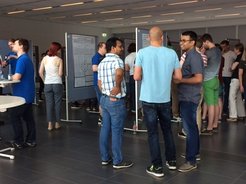Institute Seminar shows the spectrum of Catalysis Research at the MPI

Catalysis research at the Max-Planck-Institut für Kohlenforschung is very diverse. This was once again demonstrated by the summer Institute Seminar at which some 160 doctoral students, postdocs and scientific coworkers met for exchange. The institute's seminars focus on two short scientific presentations from different departments of the institute.
This time Professor Neese's Department of Molecular Theory and Spectroscopy was represented by group leader Dr. Giovanni Bistoni. Bistoni deals with computer-chemical calculation methods for intermolecular interactions in Homogeneous Catalysis. He presented different calculation methods - DFT and Coupled Cluster - and showed their possibilities and restrictions in the application. He also explained the influence of London dispersion and the solvent environment on complex quantum chemical calculations. In the subsequent round of questions, the participants actively discussed with Bistoni their own experiences with the advantages and disadvantages of the calculation methods.
The second lecture of the institute seminar came from Dr. Chunxiang Zhuo, who is a Humboldt fellow and postdoctoral researcher in Professor Fürstner's Department of Organometallic Chemistry. Chunxiang presented his research in connection with the synthesis of Pateamine A. The complex natural substance, which occurs in a sea sponge in New Zealand, could only be produced in very complex and small quantities with low efficiency. Chunxiang presented how he and his research colleagues succeeded in significantly simplifying the synthesis process through new methods and the use of modified conditions and thereby achieving a better yield of the desired active substance Pateamine A.
Professor Ritter, in his introduction, asked the scientists to participate with ideas and proposals in a new seminar series of the MPI, which is planned for the next academic year. During the subsequent poster session in the small lecture hall, all departments were able to present their latest research and discuss their topics. About 34 posters offered a colourful cross-section of the research fields and, together with a small snack, provided for lively conversations in a pleasant atmosphere.












